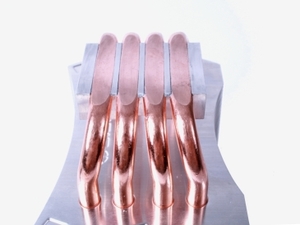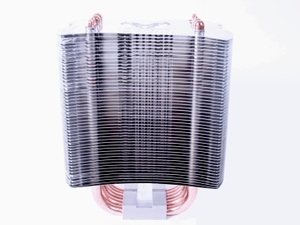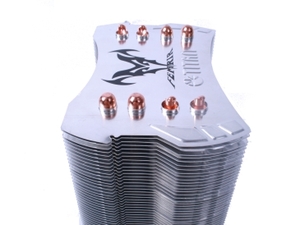
The Heatsink
The heatsink is key to performance with any CPU cooler. Shape, fin density, material and heatpipe structure all play a part and determine how much heat it can deal with and also how quickly it can transport this away from the CPU. The latter is particularly important when overclocking and having several good quality heatpipes is something we've found usually results in some fairly solid performance.Thankfully, the Fenrir has four of these arranged in the usual 'U' shape configuration. Each is 8mm wide and passes through the contact plate. This has its ups and downs though - it can result in large gaps between the heaptipes and the rest of the contact plate which need to be filled with TIM.
Clearly this isn't as ideal as having one single flat section in contact with the CPU IHS, maximising surface area contact. However, with the heatipes in direct contact with the IHS, heat transfer is pretty spectacular as it's the heatpipes that transfer the heat to the heatsink fins.
Above we can see the contact plate which has been machined to a flat surface. A majority of the contact area is taken up by the four copper heatpipes which then bend away upwards towards the aluminium fins. What's evident is how densely packed the fins are. This will certainly aid cooling and help keep the Fenrir at a manageable size, but it might not be ideal for low rpm fans. However, the relatively short distance between the contact plate and the edge of the heatpipes means they will be working very efficiently - if they're too long or go through too many angles, their performance drops off significantly.
The fins are suspended on the heatpipes which have a small groove running down each side. Into this, fit the fan mounts which secure to the fan then clip over the groove holding the fan in place. In the right hand picture the airflow therefore goes from left to right. What's fairly evident is the strange wave-like shape to the fins which we believe takes advantage of the way in which air protrudes from a fan.
In short it doesn't just go in a straight line, it expands outwards much like a ripple in a pond. The fins appear to shadow this movement slightly, with the rear half of the Fenrir containing a much larger surface area of fins to benefit from as much of the fan's airflow as possible. One thing's sure though, it's certainly not ugly.

MSI MPG Velox 100R Chassis Review
October 14 2021 | 15:04












Want to comment? Please log in.